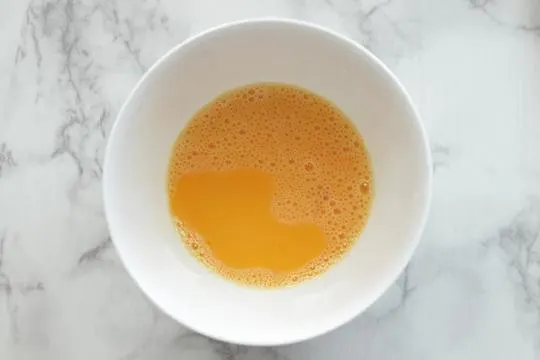Summary of key points
The main difference between milk wash and egg wash is the ingredients used. Milk wash is made from a mixture of milk and water, while egg wash involves beating eggs with either water or milk.
Both can be used as a coating for baked goods before baking to create a golden brown crust. However, egg wash will provide a richer color and flavor compared to milk wash.
In terms of texture, egg wash will create a crispier and more secure bond between the coating and the baked good. Milk wash may result in a softer crust.
The choice between milk wash and egg wash will depend on personal preference and the desired outcome for the final product. Both can be used interchangeably in most recipes, but it’s important to consider their respective differences.
Ever stared at a pastry and wondered how it got that golden glow? It’s a battle of washes, friends. Milk wash versus egg wash. Milk lends a subtle color and softness. Egg wash? It’s the secret behind that Instagram-worthy sheen.
We’ve all been there, right? Slapping on whatever’s in the fridge onto our dough. Sometimes magic happens. Other times, not so much. Here, we’re breaking it down. No more guessing games.
Our kitchens have seen it all. That time we used only milk and ended up with a pale-looking pie. Or the “egg wash experiment” that turned breakfast into a science fair project.
Now, we’re here to share the scoop. And yes, there’s a difference. A big one.
What is a Milk Wash?

Milk wash is a mix of milk and other ingredients.
It’s used before baking or cooking.
It adds a glossy finish and helps with browning.
It also binds coatings and breadcrumbs to food.
Chefs like it for improving the look and texture of baked goods.
To use it, brush or spray it on the food before putting it in the oven.
This gives a golden sheen and aroma.
Plus, it adds moisture and prevents drying.
So, using milk wash can make your cooking even more delicious and appealing.
What is an Egg Wash?

An egg wash is a mix of whisked eggs and a liquid, like water or milk.
It is often used for cooking and baking, to give a glossy finish and golden color.
Whisk the eggs thoroughly, to make sure the mix is distributed evenly.
You can choose the liquid depending on the recipe and the outcome you want.
Water works for a simple egg wash, or use milk/cream for richness.
This egg mix has a unique function – it binds.
When applied before baking, the proteins coagulate and hold things together.
This is especially helpful for pastry or dough, so they don’t separate during baking.
Plus, an egg wash is great for visuals.
It creates a golden brown color on breads, pastries, and more, making them look inviting and appetizing.
Knowing how to properly use an egg wash can take your cooking to the next level.
Differences Between Milk Wash and Egg Wash

Milk wash and egg wash are two common ingredients for coating food before baking or frying.
Both add flavor and texture, but they are different in composition and outcome.
Ingredients Used
Milk wash and egg wash are two key ingredients with noteworthy differences.
Milk wash usually consists of creamy, rich milk.
Egg wash is beaten eggs until smooth, providing a glossy finish.
Milk wash has a subtle sweetness and delicate flavor, whereas egg wash has a richer taste with a hint of savory.
Milk wash creates a golden brown crust that is soft.
Egg wash gives pastries a shiny glaze.
Texture-wise, milk wash adds moisture to bread and pastry crusts.
Egg wash promotes browning through Maillard reaction and makes it crispy.
When selecting a wash, consider dietary restrictions.
Those with egg allergies can opt for milk wash.
Taste and appeal will not be compromised.
Texture and Appearance
Texture and appearance are essential to make any dish unforgettable.
Two popular techniques, milk wash and egg wash, are used to boost the visual appeal of baked goods.
Both add texture, yet differ in terms of effect and texture.
Milk wash gives a soft and light crust with a subtle crunch.
It also gives a pale color.
Whereas, egg wash offers a glossy and golden-brown finish.
These two methods stand out due to their unique properties.
Milk wash results in a tender and delicate texture.
Egg wash, on the other hand, yields a slightly firmer texture with richer hue.
The choice between them depends on the desired outcome of the final product.
Milk wash is preferred for delicate pastries like croissants or cream puffs.
It brings out the delicate flavors without overpowering them.
Egg wash, on the other hand, helps to give depth to hearty breads or savory items such as quiches or meat pies.
Effects on Browning and Shining
When it comes to baked goods, milk wash and egg wash can make a real difference.
Milk wash gives a subtle golden color and a glossy sheen.
It’s perfect for delicate treats like croissants and puff pastry.
Egg wash has a deeper color, making it ideal for items like bread rolls and cookies.
It also has a stronger shine.
Moreover, you can customize the two washes by adding sugar or salt.
Some recipes even suggest combining milk and egg.
This creates a balance between subtlety and richness in both browning and shining.
Flavor and Taste
Flavor and taste differ between milk wash and egg wash.
Milk wash makes baked goods sweeter and creamier.
Egg wash gives them a rich flavor and glossy look.
Bakers pick which to use based on the outcome they want.
The decision between milk and egg wash is a personal preference and based on which flavors to emphasize in their recipes.
Similarities Between Milk Wash and Egg Wash

Milk wash and egg wash may appear different, but really they have similarities.
Both are used as coatings for things like pastries and breaded items.
They help get the perfect texture and look when you are baking or cooking.
Even though their compositions are different, they both help to improve the quality of the result.
Plus, they act as binding agents.
This means they give a layer that helps keep the toppings and breading together.
This makes the dish look better.
Also, they can make it golden-brown when put on before baking or frying.
Moreover, milk wash and egg wash stop food from drying out while cooking.
This keeps the texture and taste good.
Therefore, whether it’s pastry or fried chicken, these techniques make the food enjoyable to eat.
In short, milk wash and egg wash have different compositions, but they both help with texture, appearance, and taste.
So if you need to use one of them, remember their similarities and choose based on what you want to achieve.
When to Use Milk Wash and When to Use Egg Wash?
When it comes to milk wash or egg wash, it’s important to think about the end goal.
Milk wash gives a golden-brown color and softness.
Egg wash is great for a glossy and crunchy outcome.
Combining both can give you the best of both worlds.
Milk wash is perfect for lighter dishes – like scones, biscuits, and pastry crusts.
The proteins promote browning and add moisture.
Egg wash is great for things like breads, pastries, and pies.
The proteins help in caramelization – giving an attractive brown color and delicious crunch.
Both milk and egg wash can be used on dinner rolls and croissants for added tenderness and appeal.
Ultimately, it depends on the desired result.
Consider texture and appearance to make an informed decision.
Experiment with both methods to find what tastes best.
Alternative Washes for Specific Purposes
Other than milk and egg wash, alternative washes can be used for specific purposes.
These washes give baked goods a unique touch, improving their appearance, flavor, or texture.
Each one has its own characteristics which make them useful in the culinary world.
One example is honey wash.
This sticky liquid works as a natural sweetener and glaze.
It gives baked goods a shiny finish and adds a hint of sweetness.
It’s great for pastries like cinnamon rolls and buns.
Melted butter wash is another option.
This rich wash adds a golden brown color to bread crusts, making them attractive.
It also provides a rich flavor and moistness.
Sprinkling granulated sugar on top before baking adds crunchiness.
The sugar caramelizes during cooking, giving a delightful crunch.
In recipes where salt enhances flavors, a saltwater wash can be used.
This simple mixture of water and salt seasons the surface of bread or pretzels, adding savory notes.
Herbs or spices can be added to the wash for extra flavor.
For instance, brushing bread with garlic-infused olive oil makes it better.
These alternative washes offer endless possibilities.
They let bakers and chefs experiment and tailor creations to suit tastes.
So, next time you’re baking, don’t limit yourself.
Explore these alternatives and take your skills up a notch.
Conclusion
Choosing between these two options can be tricky.
Egg wash gives a richer, shinier surface, great for pastries needing a golden hue.
Milk wash is more subtle, making the crust softer and lighter.
Egg wash provides a crisp texture, while milk wash yields a softer, more tender crust.
So, if flakiness isn’t the goal, opt for milk.
In short, milk and egg wash have their own unique qualities.
It all depends on what you want to achieve with your baked goods – lustrous and rich or gentle color.
Try both and find out what works best.

Leave a comment